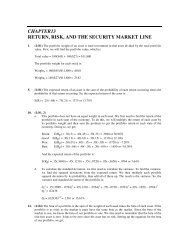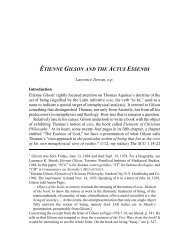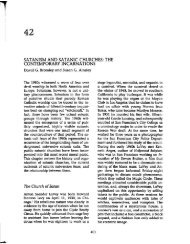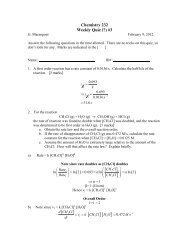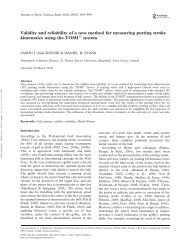Coca chewing and high altitude stress.pdf - StFX Faculty and Staff ...
Coca chewing and high altitude stress.pdf - StFX Faculty and Staff ...
Coca chewing and high altitude stress.pdf - StFX Faculty and Staff ...
Create successful ePaper yourself
Turn your PDF publications into a flip-book with our unique Google optimized e-Paper software.
y JOEL M. HANNA<br />
Department of Physiology, University of Hawaii, 1960 East-<br />
Bray <strong>and</strong> Dollery: COCA AND ALTITUDE STRESS<br />
West Rd., Biomed T-608, Honolulu, Hawaii 96822, U.S.A. ypadu powder <strong>and</strong> can remember the time when their fathers<br />
8 xii 82<br />
<strong>and</strong> gr<strong>and</strong>fathers used it regularly. On the other h<strong>and</strong>, certain<br />
Bray <strong>and</strong> Dollery have presented some rather interesting evidence<br />
that the use of coca leaves is not limited to <strong>high</strong>-<strong>altitude</strong><br />
populations. It is difficult to take issue with this point, since<br />
the evidence is overwhelming. However, their remark "There<br />
is no reason to believe that this action (coca potentiation of<br />
amine reabsorption) would have any greater effect at oxygen<br />
pressures prevailing at 3,000 m than at sea level" does require<br />
districts in the vicinity of Tefe-including some virtually on<br />
the outskirts of the town itself-are characterized by widespread<br />
coca use, notwithst<strong>and</strong>ing the fact that the population<br />
of these districts neither considers itself Indian nor even evidences<br />
a great deal of "Indianness" in its genetic or cultural<br />
traits.<br />
some clarification. One of the major consequences of life at<br />
<strong>high</strong> <strong>altitude</strong> is a continual physical <strong>stress</strong> resulting in an elevated<br />
sympathetic tone. Use of cocaine-containing coca leaves<br />
would thus potentiate this <strong>stress</strong> response, perhaps promoting<br />
greater neurotransmitter economy or enhancing the response<br />
itself. In any case, the continual hypoxic <strong>stress</strong> is limited to<br />
<strong>high</strong> elevations, <strong>and</strong> coca use would prove of special benefit<br />
there. Such a mechanism could be responsible for the persistence<br />
of coca use among <strong>high</strong>-<strong>altitude</strong> populations in the face<br />
of official pressures toward its elimination.<br />
by TED C. LEWELLEN<br />
Department of Sociology, University of Richmond, Richmond,<br />
Va. 23173, U.S.A. 25 x 82<br />
People (including anthropologists) can function perfectly well<br />
at 12,500 ft. or above without resorting to artificial stimuli.<br />
This is clearly evident in the declining use of coca in the Lake<br />
Titicaca area, where I did my fieldwork. Though I did not<br />
specifically study this issue, I am under the impression that<br />
among the Peruvian Aymara three separate factors militate<br />
against coca <strong>chewing</strong>. First, those who are relatively acculturated,<br />
through circular migration to wage-labor jobs on the<br />
by ANTHONY HENMAN<br />
coast, tend to view coca <strong>chewing</strong> as old-fashioned. Second, the<br />
Department of Anthropology, IFCH-UNICAMP, 13100<br />
Campinas SP, Brazil. 9 xi 82<br />
Seventh-Day Adventists (about 11% of the population in the<br />
communities I studied) reject coca as they would any stimu-<br />
As an ex-student of Warwick Bray's who left London with his lant <strong>and</strong> associate it with Catholicism <strong>and</strong> the traditional reencouragement<br />
in 1973 to study the use of coca in Colombia, ligion. Finally, public education, usually taught by young mes-<br />
I can only welcome the thorough <strong>and</strong> incisive treatment of tizos, demeans those Indian values the state perceives as negathe<br />
theme in this paper. The kind of biological determinism tive. Thus, though coca remains an essential ingredient in<br />
inherent in the correlation of coca <strong>chewing</strong> <strong>and</strong> human sur- Aymara ritual, its casual, daily use is largely confined to those<br />
vival at <strong>high</strong> <strong>altitude</strong>s has all too often been misappropriated who are old <strong>and</strong>/or relatively unacculturated.<br />
by the narcotics agencies, <strong>and</strong> the resulting cant has led to<br />
at least one ludicrous piece of legislation that has direct bearing<br />
on the issues discussed by the authors: the prohibition of<br />
On the other h<strong>and</strong>, the value of coca-<strong>chewing</strong> for preventing<br />
soroche is widely known, <strong>and</strong> the leaves are sometimes used<br />
for this purpose even by urban cholos or mestizos. The father<br />
the use of coca in Peru at <strong>altitude</strong>s below 1,500 m, promul- of a family I lived with in Cochabamba, Bolivia, would use<br />
gated with the encouragement of the U.S. Drug Enforcement<br />
Administration in 1978.<br />
coca only when he drove up to 15,000 or 16,000 ft. to hunt<br />
bizcacha.<br />
My only major reservation concerns the replacement of the<br />
correlation between coca <strong>chewing</strong> <strong>and</strong> <strong>high</strong>-<strong>altitude</strong> living with<br />
Altitudes under 15,000 ft. would not be a problem for someone<br />
who is <strong>altitude</strong>-adapted <strong>and</strong> in good health. However, there<br />
the less spurious but nonetheless imprecise "link . . . between<br />
coca use <strong>and</strong> the persistence of relatively unacculturated Incan<br />
be little doubt that <strong>high</strong> <strong>altitude</strong> is significant when it is<br />
combined with poor nutrition or disease. In such cases the<br />
dian communities." Anthropologists have always experienced<br />
some difficulty in defining "Indianness," <strong>and</strong> in recent years<br />
many have moved away from genetic, cultural, <strong>and</strong>/or histormild<br />
stimulant of coca may be, if not essential, at least useful<br />
in carrying on normal activities. Since the poorer communities<br />
are also usually the more traditional, the correlation between<br />
ical criteria towards the more explicit but no less problematic<br />
self-identification. In line with this thinking <strong>and</strong> the authors'<br />
argument, one would not expect to find the use of coca among<br />
coca <strong>chewing</strong> <strong>and</strong> tradition may have some basis in biology.<br />
The adaptive value of coca should not, therefore, be entirely<br />
ruled out, though the <strong>stress</strong>es it alleviates are general ones<br />
those who, despite their ancestry, no longer consider them- that are merely amplified at <strong>high</strong> <strong>altitude</strong>s.<br />
selves Indians <strong>and</strong> are not seen as such by the surrounding In any case, the authors present a good case that coca chewpopulation.<br />
ing did not evolve primarily as a response to the <strong>stress</strong>es of<br />
In at least two areas that I have researched personally, <strong>altitude</strong>, <strong>and</strong> thus they provide a welcome corrective to some<br />
however, the data plainly do not support this view. One is the perhaps overzealous attempts at a direct correlation between<br />
region of southern Cauca, Colombia, where the use of coca by<br />
the Spanish-speaking peasantry-including, incidentally, the<br />
biology <strong>and</strong> culture.<br />
descendants of African slaves-contrasts notably with the<br />
more typical Andean pattern of the Paez of Tierradentro. This<br />
is a theme developed in some detail in my book Mama <strong>Coca</strong><br />
(Antonil 1978), where I also point out the converse case of<br />
by MICHAEL A. LITTLE<br />
Department of Anthropology, State University of New York,<br />
Binghamton, N.Y. 13901, U.S.A. 1 xi 82<br />
the Guambiano Indians of Silvia, who have ab<strong>and</strong>oned the use<br />
of coca almost completely in recent years, <strong>and</strong> this despite the<br />
survival of a life-style which in most other respects is con-<br />
Bray <strong>and</strong> Dollery have done a very scholarly job in demonstrating<br />
that coca use was quite widespread in pre-Hispanic<br />
times in the Andean nations <strong>and</strong> that it was not exclusively<br />
siderably less "acculturated" than that of the Paez.<br />
a <strong>high</strong>-<strong>altitude</strong> practice. This information weakens, of course,<br />
The other area, surrounding the town of Tefe in the Brazil- the hypothesis that coca use confers some advantage on<br />
ian state of Amazonas, I visited only more recently (1981). coqueros at <strong>high</strong> <strong>altitude</strong>, but it does not falsify it. Testing<br />
The only self-defined "Indians" in this region, the Miranha this hypothesis is a difficult task requiring numerous studies.<br />
cultivate the coca bush today exclusively for medicinal pur- It is a task that no rational investigator should attempt withposes,<br />
though some of the older men still know how to prepare out enormous resources <strong>and</strong> time.<br />
Vol. 24 No. N 3 * June 1983<br />
277



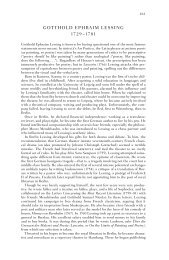
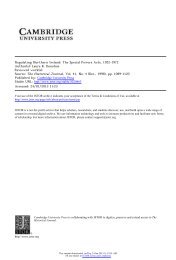


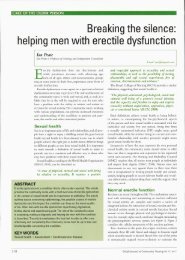
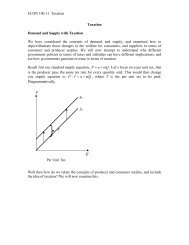
![The Rink - Cyril Dabydeen[1].pdf](https://img.yumpu.com/21946808/1/155x260/the-rink-cyril-dabydeen1pdf.jpg?quality=85)

